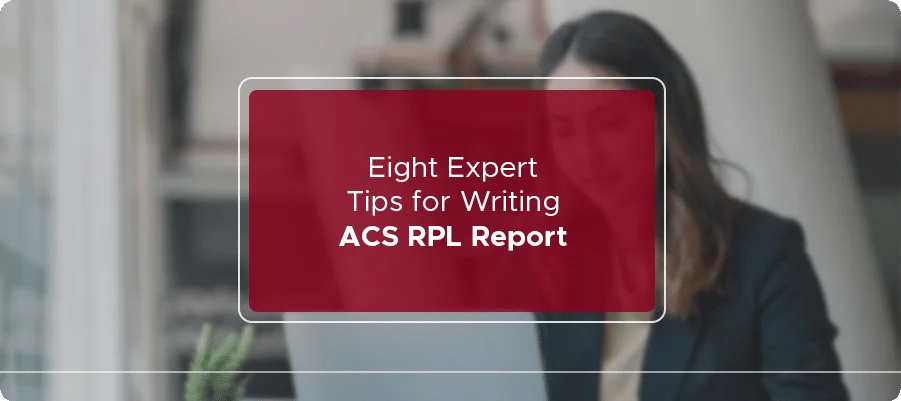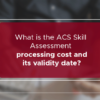
Eight Expert Tips for Writing ACS RPL Report
If you’re a skilled IT professional looking to migrate to Australia, you’ll likely encounter the term “RPL” during your journey. The Recognition of Prior Learning (RPL) is a crucial step in the Australian Computer Society (ACS) skill assessment process for those lacking a formal IT degree. ACS RPL reports provide a platform to showcase your skills, knowledge, and experience in information and communications technology (ICT) to ACS assessors.
A compelling RPL report is paramount to a successful ACS skill assessment application. This comprehensive blog will provide eight expert tips to help you write an ACS RPL report that will impress the assessors and enhance your chances of achieving a positive outcome.
Expert tips for writing an ACS RPL Report
Below are expert tips for writing an impressive ACS RPL Report:

1. Understand the ACS Guidelines
Before diving into the writing process, it’s crucial to understand the ACS guidelines for RPL submissions thoroughly. The ACS provides clear instructions in the ACS Skills Assessment Guidelines for Applicants, which outline the format and content requirements for RPL reports. Please pay close attention to these guidelines, as ACS assessors follow them closely when evaluating your application.
Key points to consider include:
- The two sections of the RPL report are the Key Areas of Knowledge (KAoK) and the Project Reports.
- The format requirements for each section include the maximum word count.
- The use of Australian English and the need for accurate spelling and grammar.
- The requirement is to include two project reports demonstrating your skills and knowledge.
2. Choose Relevant Projects
The heart of your RPL report lies in the project reports you submit. These reports showcase your practical experience and skills in ICT. It’s essential to select projects that are directly relevant to the ANZSCO code you’re applying for, as this ensures your application aligns with ACS requirements.
When choosing projects, consider the following:
- The projects should align with the ANZSCO code you’re targeting. Ensure that your role and responsibilities in these projects correspond to the nominated occupation.
- Select projects where you played a significant role and had substantial responsibilities. The assessors are interested in your contributions and achievements.
- Only use projects that are old or updated, as technology evolves rapidly. Aim for projects completed within the last ten years.
3. Follow the STAR Method
In your project reports, use the STAR method to structure your responses. STAR stands for Situation, Task, Action, and Result. This method provides a clear and concise way to convey your experience and achievements.
Here’s how to apply the STAR method in your RPL report:
- Situation: Start by describing the context or situation you encountered in the project. Explain the challenges or issues that need to be addressed.
- Task: Outline your specific role and responsibilities in the project. What tasks were assigned to you? What were the goals and objectives?
- Action: Detail your actions to address the challenges and fulfill your responsibilities. Be specific about the tools, technologies, and methodologies you used.
- Result: Share the outcomes of your actions. Highlight any achievements, improvements, or successful project outcomes. Quantify your results whenever possible, such as cost savings or efficiency gains.
Using the STAR method not only helps you structure your responses but also allows assessors to understand your contributions and the impact of your work quickly.
Learn More: How to Write an ACS RPL Report for Database Administrator? ✈️✈️
4. Focus on Key Areas of Knowledge (KAoK)
The Key Areas of Knowledge (KAoK) section of your RPL report is where you demonstrate your theoretical knowledge in ICT. Addressing all the KAoK areas specified in the ACS guidelines for your chosen ANZSCO code is essential. Provide concise explanations and examples for each area, drawing from your education and work experience.
Here are some tips for addressing the KAoK section effectively:
- Research each KAoK area to ensure you thoroughly understand the concepts.
- Use clear and precise language to explain your knowledge in each area.
- Provide real-world examples from your work or education illustrating your understanding of the KAoK.
Remember that assessors will seek evidence that you possess the necessary knowledge to perform effectively in your nominated occupation.
5. Demonstrate Continuous Professional Development (CPD)
The ACS values ongoing professional development, and your RPL report is an opportunity to showcase your commitment to staying current in the field of ICT. Include a section in your report that highlights your CPD activities, such as courses, certifications, seminars, workshops, or conferences you’ve attended.
Here’s how to effectively present your CPD:
- List the relevant courses and certifications you’ve completed, including their names, dates, and issuing institutions.
- Explain how these activities have enhanced your skills and knowledge.
- Link your CPD to the KAoK areas and your nominated occupation to demonstrate relevance.
Emphasizing your commitment to CPD underscores your dedication to the IT profession and aligns with ACS’s expectations.
6. Proofread and Edit Thoroughly
In the eyes of ACS assessors, attention to detail matters. Mistakes in spelling, grammar, or formatting can detract from the professionalism of your RPL report. After writing your report, take the time to proofread and edit it meticulously. Consider enlisting the help of a specific professional editor or a trusted colleague to review your work.
Here’s what to look for during the editing process:
- Correct any spelling and grammar errors. Ensure consistent use of Australian English.
- Check formatting and style to adhere to ACS guidelines. Verify that your report meets the specified word count limits.
- Review the overall flow and clarity of your writing. Make sure your content is easy to understand and well-organized.
A well-polished RPL report demonstrates your commitment to excellence and professionalism.
Learn More: How to prepare CPD for your CDR Report? 🧑🏽✈️🏆
7. Avoid Plagiarism
Plagiarism is a severe problem and can lead to your RPL application being rejected. ACS assessors rigorously check for originality and authenticity in RPL reports. All content, including project descriptions, must be your work and accurately represent your experience.
To avoid plagiarism:
- Write your project reports and KAoK explanations in your own words.
- If you need to reference external sources or standards, cite them properly.
- Do not copy-paste text from the internet or any other sources.
Maintaining academic integrity is crucial throughout the RPL process to avoid RPL Report rejection.
8. Seek Professional Guidance
Writing an ACS RPL report can be a challenging and time-consuming task. Consider seeking professional guidance if you need clarification on any aspect of the process or assistance. Many organizations and consultants specialize in helping individuals prepare successful ACS RPL reports. They can give valuable insights, review your application, and offer feedback to ensure it meets ACS standards.
When seeking professional assistance, be sure to:
- Choose a specific reputable provider with a track record of successful RPL submissions.
- Communicate your background, skills, and career goals to the consultant.
- Review any agreements or contracts carefully before engaging their services.
Professional guidance can significantly increase your chances of a positive ACS assessment outcome.
Learn More: Can an Engineering technologist get a PR Visa? ⏱⌛️
Conclusion
Crafting a compelling ACS RPL report is a crucial step in your journey to obtain a skilled migration visa to Australia. Following the ACS guidelines, selecting relevant projects, using the STAR method, addressing the Key Areas of Knowledge, showcasing continuous professional development, proofreading rigorously, avoiding plagiarism, and seeking professional guidance are key strategies to ensure your RPL report stands out and impresses the assessors.
Remember that the RPL process is an opportunity to demonstrate your qualifications and experience, even if you still need a formal IT degree. By creating a well-crafted RPL report, you can significantly boost your chances of getting a positive result in your ACS skill assessment and taking the next step toward a successful career in Australia’s vibrant IT industry.





